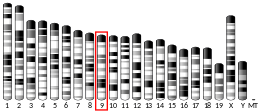RNF7
RING-box protein 2 is a protein that in humans is encoded by the RNF7 gene.[5][6][7]
The protein encoded by this gene is a highly conserved ring finger protein. It is an essential subunit of SKP1-cullin/CDC53-F box protein ubiquitin ligases, which are a part of the protein degradation machinery important for cell cycle progression and signal transduction. This protein interacts with, and is a substrate of, casein kinase II (CSNK2A1/CKII). The phosphorylation of this protein by CSNK2A1 has been shown to promote the degradation of IkappaBalpha (CHUK/IKK-alpha/IKBKA) and p27Kip1(CDKN1B). Alternatively spliced transcript variants encoding distinct isoforms have been reported.[7]
Interactions
RNF7 has been shown to interact with CSNK2B.[8]
gollark: No.
gollark: Impractical based on my understanding of how humans work, which is not perfecto bviously.
gollark: "Communism" seems to either mean heavy centrally planned economies, which is no, or anarchocommunist-y "communes", which is impractical.
gollark: Sorry, I meant arachno.
gollark: * arachnoaccelerationism
See also
References
- GRCh38: Ensembl release 89: ENSG00000114125 - Ensembl, May 2017
- GRCm38: Ensembl release 89: ENSMUSG00000051234 - Ensembl, May 2017
- "Human PubMed Reference:". National Center for Biotechnology Information, U.S. National Library of Medicine.
- "Mouse PubMed Reference:". National Center for Biotechnology Information, U.S. National Library of Medicine.
- Duan H, Wang Y, Aviram M, Swaroop M, Loo JA, Bian J, Tian Y, Mueller T, Bisgaier CL, Sun Y (April 1999). "SAG, a novel zinc RING finger protein that protects cells from apoptosis induced by redox agents". Mol Cell Biol. 19 (4): 3145–55. doi:10.1128/MCB.19.4.3145. PMC 84108. PMID 10082581.
- Ohta T, Michel JJ, Schottelius AJ, Xiong Y (May 1999). "ROC1, a homolog of APC11, represents a family of cullin partners with an associated ubiquitin ligase activity". Mol Cell. 3 (4): 535–41. doi:10.1016/S1097-2765(00)80482-7. PMID 10230407.
- "Entrez Gene: RNF7 ring finger protein 7".
- Ahn, B H; Kim T H; Bae Y S (October 2001). "Mapping of the interaction domain of the protein kinase CKII beta subunit with target proteins". Mol. Cells. Korea (South). 12 (2): 158–63. ISSN 1016-8478. PMID 11710515.
Further reading
- Tan P, Fuchs SY, Chen A, et al. (1999). "Recruitment of a ROC1-CUL1 ubiquitin ligase by Skp1 and HOS to catalyze the ubiquitination of I kappa B alpha". Mol. Cell. 3 (4): 527–33. doi:10.1016/S1097-2765(00)80481-5. PMID 10230406.
- Swaroop M, Bian J, Aviram M, et al. (1999). "Expression, purification, and biochemical characterization of SAG, a ring finger redox-sensitive protein". Free Radic. Biol. Med. 27 (1–2): 193–202. doi:10.1016/S0891-5849(99)00078-7. PMID 10443936.
- Sun Y (1999). "Alterations of SAG mRNA in human cancer cell lines: requirement for the RING finger domain for apoptosis protection". Carcinogenesis. 20 (10): 1899–903. doi:10.1093/carcin/20.10.1899. PMID 10506102.
- Son MY, Park JW, Kim YS, et al. (1999). "Protein kinase CKII interacts with and phosphorylates the SAG protein containing ring-H2 finger motif". Biochem. Biophys. Res. Commun. 263 (3): 743–8. doi:10.1006/bbrc.1999.1460. PMID 10512750.
- Chen A, Wu K, Fuchs SY, et al. (2000). "The conserved RING-H2 finger of ROC1 is required for ubiquitin ligation". J. Biol. Chem. 275 (20): 15432–9. doi:10.1074/jbc.M907300199. PMID 10748083.
- Swaroop M, Wang Y, Miller P, et al. (2000). "Yeast homolog of human SAG/ROC2/Rbx2/Hrt2 is essential for cell growth, but not for germination: chip profiling implicates its role in cell cycle regulation". Oncogene. 19 (24): 2855–66. doi:10.1038/sj.onc.1203635. PMID 10851089.
- Furukawa M, Zhang Y, McCarville J, et al. (2000). "The CUL1 C-terminal sequence and ROC1 are required for efficient nuclear accumulation, NEDD8 modification, and ubiquitin ligase activity of CUL1". Mol. Cell. Biol. 20 (21): 8185–97. doi:10.1128/MCB.20.21.8185-8197.2000. PMC 86428. PMID 11027288.
- Duan H, Tsvetkov LM, Liu Y, et al. (2001). "Promotion of S-phase entry and cell growth under serum starvation by SAG/ROC2/Rbx2/Hrt2, an E3 ubiquitin ligase component: association with inhibition of p27 accumulation". Mol. Carcinog. 30 (1): 37–46. doi:10.1002/1098-2744(200101)30:1<37::AID-MC1011>3.0.CO;2-7. PMID 11255262.
- Swaroop M, Gosink M, Sun Y (2001). "SAG/ROC2/Rbx2/Hrt2, a component of SCF E3 ubiquitin ligase: genomic structure, a splicing variant, and two family pseudogenes" (PDF). DNA Cell Biol. 20 (7): 425–34. doi:10.1089/104454901750361488. hdl:2027.42/63441. PMID 11506706.
- Ahn BH, Kim TH, Bae YS (2002). "Mapping of the interaction domain of the protein kinase CKII beta subunit with target proteins". Mol. Cells. 12 (2): 158–63. PMID 11710515.
- Furukawa M, Ohta T, Xiong Y (2002). "Activation of UBC5 ubiquitin-conjugating enzyme by the RING finger of ROC1 and assembly of active ubiquitin ligases by all cullins". J. Biol. Chem. 277 (18): 15758–65. doi:10.1074/jbc.M108565200. PMID 11861641.
- Kim SY, Bae YS, Park JW (2002). "Thiol-linked peroxidase activity of human sensitive to apoptosis gene (SAG) protein". Free Radic. Res. 36 (1): 73–8. doi:10.1080/10715760210164. PMID 11999705.
- Kim YS, Ha KS, Kim YH, Bae YS (2003). "The Ring-H2 finger motif of CKBBP1/SAG is necessary for interaction with protein kinase CKII and optimal cell proliferation". J. Biochem. Mol. Biol. 35 (6): 629–36. doi:10.5483/bmbrep.2002.35.6.629. PMID 12470599.
- Strausberg RL, Feingold EA, Grouse LH, et al. (2003). "Generation and initial analysis of more than 15,000 full-length human and mouse cDNA sequences". Proc. Natl. Acad. Sci. U.S.A. 99 (26): 16899–903. Bibcode:2002PNAS...9916899M. doi:10.1073/pnas.242603899. PMC 139241. PMID 12477932.
- Kim SY, Lee JH, Yang ES, et al. (2003). "Human sensitive to apoptosis gene protein inhibits peroxynitrite-induced DNA damage". Biochem. Biophys. Res. Commun. 301 (3): 671–4. doi:10.1016/S0006-291X(03)00018-4. PMID 12565832.
- Kim YS, Lee JY, Son MY, et al. (2003). "Phosphorylation of threonine 10 on CKBBP1/SAG/ROC2/Rbx2 by protein kinase CKII promotes the degradation of IkappaBalpha and p27Kip1". J. Biol. Chem. 278 (31): 28462–9. doi:10.1074/jbc.M302584200. PMID 12748192.
- Gerhard DS, Wagner L, Feingold EA, et al. (2004). "The status, quality, and expansion of the NIH full-length cDNA project: the Mammalian Gene Collection (MGC)". Genome Res. 14 (10B): 2121–7. doi:10.1101/gr.2596504. PMC 528928. PMID 15489334.
- Rual JF, Venkatesan K, Hao T, et al. (2005). "Towards a proteome-scale map of the human protein-protein interaction network". Nature. 437 (7062): 1173–8. Bibcode:2005Natur.437.1173R. doi:10.1038/nature04209. PMID 16189514.
External links
- RNF7+protein,+human at the US National Library of Medicine Medical Subject Headings (MeSH)
This article is issued from Wikipedia. The text is licensed under Creative Commons - Attribution - Sharealike. Additional terms may apply for the media files.




